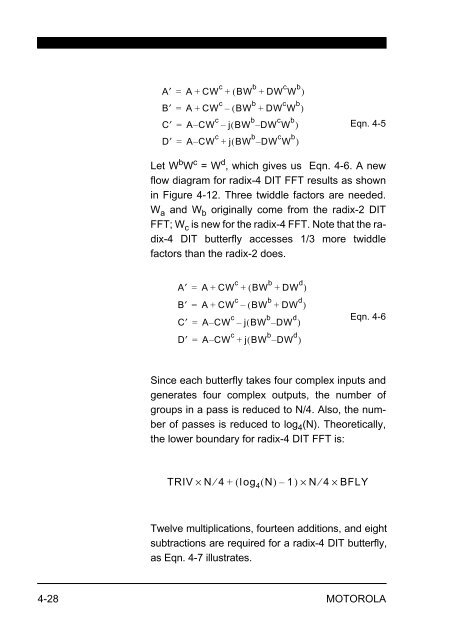Fast Fourier Transforms on Motorola's Digital Signal Processors
Fast Fourier Transforms on Motorola's Digital Signal Processors
Fast Fourier Transforms on Motorola's Digital Signal Processors
Create successful ePaper yourself
Turn your PDF publications into a flip-book with our unique Google optimized e-Paper software.
A′ A CW c<br />
BW b DW c W b<br />
= + + ( + )<br />
B′ A CW c<br />
BW b DW c W b<br />
= + – ( + )<br />
C′ A– CW<br />
c<br />
jBW b – DW<br />
c W b<br />
= – ( )<br />
D′ A– CW<br />
c<br />
jBW b – DW<br />
c W b<br />
= + ( )<br />
Eqn. 4-5<br />
Let W b W c = W d , which gives us Eqn. 4-6. A new<br />
flow diagram for radix-4 DIT FFT results as shown<br />
in Figure 4-12. Three twiddle factors are needed.<br />
W a and W b originally come from the radix-2 DIT<br />
FFT; W c is new for the radix-4 FFT. Note that the radix-4<br />
DIT butterfly accesses 1/3 more twiddle<br />
factors than the radix-2 does.<br />
A′ A CW c<br />
BW b DW d<br />
= + + ( + )<br />
B′ A CW c<br />
BW b DW d<br />
= + – ( + )<br />
C′ A– CW<br />
c<br />
jBW b – DW<br />
d<br />
= – ( )<br />
D′ A– CW<br />
c<br />
jBW b – DW<br />
d<br />
= + ( )<br />
Eqn. 4-6<br />
Since each butterfly takes four complex inputs and<br />
generates four complex outputs, the number of<br />
groups in a pass is reduced to N/4. Also, the number<br />
of passes is reduced to log 4 (N). Theoretically,<br />
the lower boundary for radix-4 DIT FFT is:<br />
TRIV × N ⁄ 4 +<br />
( log4(<br />
N)<br />
– 1) × N ⁄ 4 × BFLY<br />
Twelve multiplicati<strong>on</strong>s, fourteen additi<strong>on</strong>s, and eight<br />
subtracti<strong>on</strong>s are required for a radix-4 DIT butterfly,<br />
as Eqn. 4-7 illustrates.<br />
4-28 MOTOROLA

















